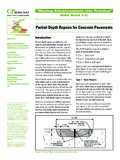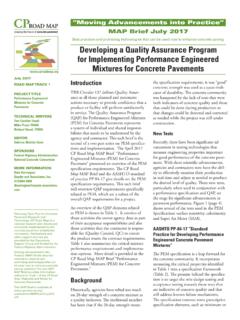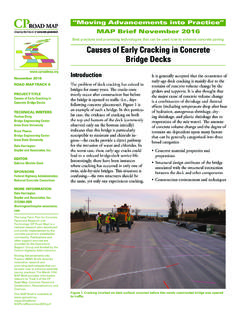Transcription of Best practices and promising technologies that can …
1 Performance Engineered Mixtures (PEM) for Concrete PavementsThe Long-Term Plan for Concrete Pavement research and Technology (CP Road Map) is a national research plan developed and jointly implemented by the concrete pavement stakeholder community. Publications and other support services are provided by the Operations Support Group and funded by the Federal Highway Advancements into Practice (MAP) Briefs describe innovative research and promising technologies that can be used now to enhance concrete paving practices . The April 2017 MAP Brief provides information relevant to Track 1 of the CP Road Map: Materials and Mixes for Concrete MAP Brief is available at pdf.
2 Moving Advancements into Practice MAP Brief April 2017 Best practices and promising technologies that can be used now to enhance concrete 2017 ROAD MAP TRACK 1 PROJECT TITLE Performance Engineered Mixtures for Concrete PavementsTECHNICAL WRITERS Tom Cackler (lead) Dale Harrington Peter C. Taylor CONTRIBUTORS Tyler Ley Larry Sutter Jason Weiss Tom VanDam EDITOR Sabrina Shields-Cook SPONSORS Federal Highway Administration National Concrete Consortium MORE INFORMATION Dale Harrington Snyder and Associates, Inc. (515)964-2020 comIntroductionConcrete pavements are designed to perform for decades under harsh service conditions. Owners invest in them because of their ability to provide a safe, low-maintenance, long-life solution to a full range of needs, from low-volume secondary roads to the highest volume interstate applications in the country.
3 With recent advancements in testing technologies , it is now possible to more directly measure the key properties of concrete paving mixtures that relate to per-formance and design them to perform with increased reliability in all climatic regions. This tech brief will explain how concrete paving mixtures can be engineered to meet performance requirements and how to in-corporate key performance parameters into a robust specification and quality performance-engineered mixtures are neededConcrete paving specifications have not kept pace with advancements in concrete science and innovations in testing technologies . Current specifications are still largely based on strength, slump, and air content and have been for over 50 years.
4 While these are important parameters, there are other parameters that are not being measured that are equally or more important. Mixtures have become more complex with a growing range of chemical admixtures and supple-mentary cementitious materials (SCMs). Traffic is increasing, more aggressive winter maintenance practices are the norm, and demands are growing for systems to be built more quickly, less expensively, and with increased longevity. Many local specifications are predominantly prescriptive, thus limiting the potential for innovation and not necessarily addressing current materials, environments, or construc-tion the need to advance concrete paving specifications, the Federal Highway Administration (FHWA), the American Concrete Paving Association, the Portland Cement Association and other industry partners, and member states of the National Concrete Consortium (NCC) are collaborat-ing with the research and technical com-munity to modernize the specifications for paving mixtures.
5 This partnership formally began in April of 2015 at the spring meeting of the NCC with the formation of an Expert Task Group that included seven champion states (Indiana, Iowa, Minnesota, Michigan, Nebraska, South Dakota, Wisconsin, the Illi-nois Tollway, and Manitoba). FHWA s shared vision was to have a provisional American Association of State Highway and Transpor-tation Officials (AASHTO) specification by 2017. This vision has become a April of 2017, AASHTO will publish PP 84-17, Developing Performance EngineeringConcrete Pavement Mixtures (figure 1). Thefocus now shifts from this first step to techni-cal education of agencies and industry onhow to apply the PEM specification withinan integrated framework that provides forinnovation and local Practice for Developing Performance Engineered Concrete Pavement MixturesAASHTO Designation: PP 84-171 Tech Section: 3c, Hardened Concrete Release: Group 1 (April 2017) Tech Brief working copy American Association of State Highway and Transportation Officials 444 North Capitol Street , Suite 249 Washington, 20001 Figure 1.
6 AASHTO PP 84-17 specificationCP Road MAP Brief April 2017CP Road MAP Brief April 201723 AASHTO PP84-17 test summaryWhere is the test used?Special notesMixture parameterTraditional acceptance criteriaPropertySpecification referenceSpecified testSelection detailsMixture qualificationAcceptanceAggregate stability , ASTM C1646 Alkali aggregate Transport propertiesWater to cementitious materials (w/cm) only one The required maximum water to cementitious ratio is selected based on freeze thaw conditionsFormation 1 Based on freeze thaw conditions; other criteria could be selectedIonic penetration, F X2 Determined using guidance provided in Appendix X2 Durability of hydrated cement paste for freeze-thaw durabilityWater to cementitious materials (w/cm) Choose either or Fresh air , T196, TP118 Choose only one Fresh air , T196, TP118 Time to critical "Bucket Test" Variation controlled with mixture proportion observation or F factor and porosity measuresDeicing salt SCMsChoose only one Are calcium or magnesium chloride usedDeicing salt Are calcium or magnesium chloride used.
7 Use specified sealersCalcium oxychloride 365-17 Are calcium or magnesium chloride usedReducing unwanted slab warping and cracking due to shrinkageVolume of paste (25%) Choose only one Unrestrained volume C157 Curing conditionsUnrestrained volume C157 Restrained 334 Restrained 363-17 (Dual Ring) Probability of X1 Variation controlled with mixture proportion observation or F factor and porosity control checkCommentary Concrete strength Flexural 97 Choose either or both Compressive 22 WorkabilitySlumpBox 3 Choose one V-Kelly 4 The PEM specification is structured around the recom-mendations of the expert task group concerning the critical parameters that determine concrete paving mixture perfor-mance.
8 The concept is to implement these requirements in the fol-lowing order: Mixture qualification Material and mixture properties forlocal conditions Mixture verification At the project level Mixture quality control and acceptanceTable 1 summarizes section 6 of AASHTO PP84-17 as it relates to concrete mixture performance. For each of the above six mixture properties, PP-84-17 provides a range of options from prescriptive methods to performance measures. The intent is to provide state highway agenices (SHAs) flexibility in their approach to addressing the desired performance measure. As SHAs gain experience and confidence in the performance of PEM mixtures, it is expected that specifications will become more performance based and allow for the innova-tion that is needed to increase performance.
9 The inclusion of performance measures increases the importance of quality control (Q/C), as the acceptance criteria are predicted on a well-designed and executed quality 1. Summary of AASHTO PP84-17 specificationIdentified Properties Controlling Concrete Mixture PerformanceThe following six mixture properties are addressed in section 6 of the specification: Aggregate Stability including alkali aggregate reac-tion and D-cracking Fluid Transport Properties The ability to resist pas-sage of water and aggressive fluids Cold Weather The ability to resist freezing andthawing and the effects of deicing salts Shrinkage As it affects random cracking as well aswarping Strength The ability to carry static, dynamic, andfatigue loads Workability As it affects the constructability of thesystem, and the observation that the efforts to over-come poor workability can impact durabilityOverview of PEM mixture requirementsCP Road MAP Brief April 20174 Where will PEM mixtures be beneficial?
10 The PEM specification is applicable to all states. It gives agencies the flexibility to customize their specification for a specific climatic zone, whether cold, humid, or arid (figure 2) and to measure key parameters related to performance. When considering the exposure conditions for a pave-ment, it is important to understand the impact of winter maintenance practices . In 2016, Clear Roads completed the second year of a multi-year project to systematically gather, compile, and analyze a range of data from SHAs related to their winter operations (figure 3).All SHAs were invited to participate in a survey to col-lect information about their winter resources, materials and costs for the winter season from July 1, 2015 to June 30, 2016.



